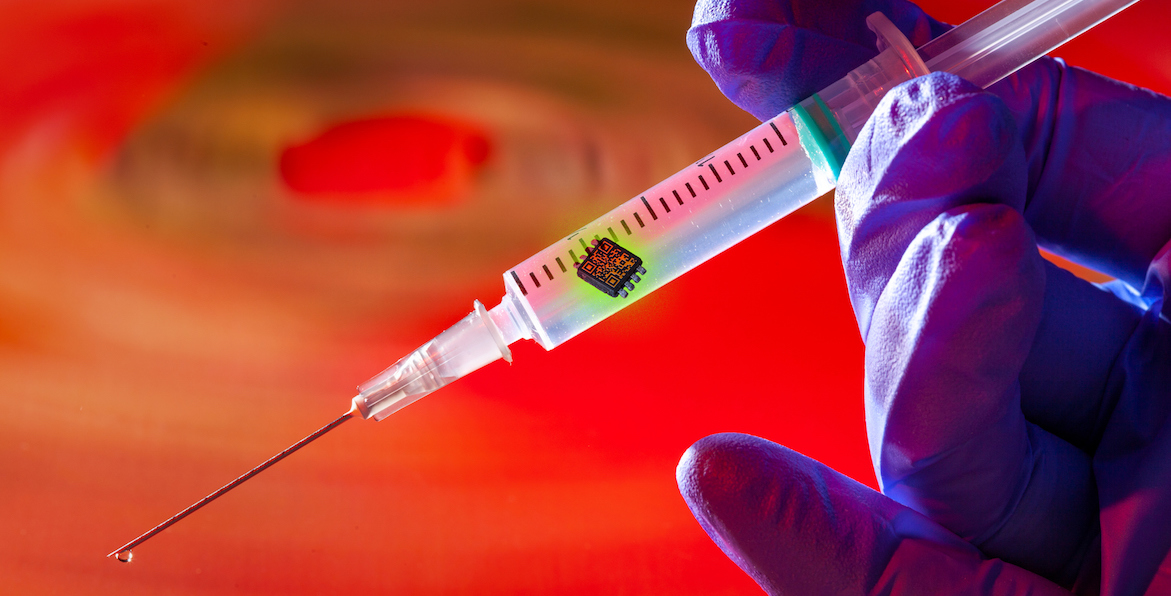<< Back
What’s in a Vaccine? (Hint: Not a Microchip)

July 07, 2021
Most vaccine mistrust is based on misinformation. Even before COVID-19, skeptics insisted vaccines contained dangerous amounts of mercury, enough aluminum to cause Alzheimer’s and even linked the measles vaccine to autism.
All false. The COVID-19 vaccines, however, have produced a conspiratorial conflagration. One of the wildest conspiracy theories that refuses to die links the vaccine to efforts at establishing a global surveillance system. How? By injecting a microchip into the arm of anyone vaccinated.
Never mind that the technology to deliver a microchip via a vaccine does not exist. Social media videos continue to purportedly prove the existence of the microchip by using a magnet or a device to detect pet chips. A recent TikTok video showed a positive reading when a pet-chip detector, used to identify lost animals, was placed over the arm of a vaccinated woman. The video received more than 1.1 million likes before moving to Facebook and Instagram.
Then the woman who posted the video described it as a joke. “It’s obviously a dog chip” the reader detected, she said.
“There are no trackers in the vaccines themselves,” says the Centers for Disease Control and Prevention. “State governments track where you got the vaccine and which kind you received using a computerized database to make sure you get all recommended doses at the right time.”
If not a microchip, then, what’s in a vaccine?
This might disappoint some people, but it’s pretty basic:
- Antigen: A vaccine’s active component that generates an immune response. The Pfizer-BioNTech and Moderna vaccines are the first to use messenger RNA, or mRNA, technology that includes the code of the specific virus antigen.
- Preservatives: Prevent contamination after the vial is opened. A common preservative, 2-phenoxyethanol, has little toxicity in humans. It’s also found in baby care products.
- Stabilizers: Prevent chemical reactions within the vaccine. These can include sugars such as lactose or sucrose, amino acids, gelatin and proteins.
- Surfactants: Maintains a well-blended vaccine, with no sediment or clumping. These surfactants are often found in ice cream and other consumer products.
- Residuals: Trace amounts of non-active elements used in manufacturing, typically measured in parts per million or parts per billion.
- Dilutent: This is most of what you see in a vaccine vial — the liquid that dilutes the vaccine. Most often, it’s sterile water.
- Adjuvant: An ingredient, a tiny amount of aluminum salts, designed to enhance immune response by stimulating immune cells near the injection site or extending the time the vaccine spends at the injection site.
“When you get a vaccine,” says Dr. Virginia Bieluch, Chief of Infectious Diseases at The Hospital of Central Connecticut in New Britain, “we often get a little bit of fever, a sore arm, some muscle aches – you may not feel well for a day or so – and that’s often attributed to a side effect of the vaccine. But it’s really your immune system working. And that’s good.”
Remember aluminum’s link to Alzheimer’s? Aluminum salts have been used in vaccines for more than 70 years as an adjuvant — from the Latin adjuvare, meaning “to help.” Some studies have linked high amounts of aluminum to brain and bone disease, but only when a person’s kidneys aren’t functioning properly. Vaccines, in contrast, contain scant amounts of aluminum that won’t affect the amount in the bloodstream. Note: Babies always have about 5 nanograms of naturally-occurring aluminum in their bloodstream.
Mercury concerns originated with flu vaccines containing thimerosal, a mercury-based preservative. The mercury found in some fish, methylmercury, is toxic to the central and peripheral nervous system. But the flu vaccine contains ethylmercury, which does not stay in the body as long as methylmercury and thus does not reach dangerous levels. Thimerosal, once in the body, becomes ethylmercury and thiosalicylate, which are quickly processed and removed from the body.
In 2001, thimerosal was removed from childhood vaccines. Thimerosal’s safety is back by several studies that have shown no evidence of potential harm. Some people, however, are allergic to thimerosal. Keep in mind that thimerosal-free flu vaccines are available in single-dose vials.
Vaccines for measles, mumps, rubella, chickenpox, inactivated polio and pneumococcal conjugate have never contained thimerosal.
The suspicion about autism and the measles vaccine is associated with an article in the journal Lancet in 1998 by British physician Andrew Wakefield that linked the vaccine to autism in children. Although the article was debunked — Wakefield was subsequently banned from practicing medicine — parents in several areas around the country, still clinging to the vaccine-autism myth, have not allowed their children to be vaccinated.
A 2013 CDC study supported previous research that vaccines do not cause autism spectrum disorder by comparing antigens, which stimulate the immune system to produce antibodies that fight disease, in the first two years of life. The study found identical amount of antigens from vaccines in children with autism and those who did not have autism.